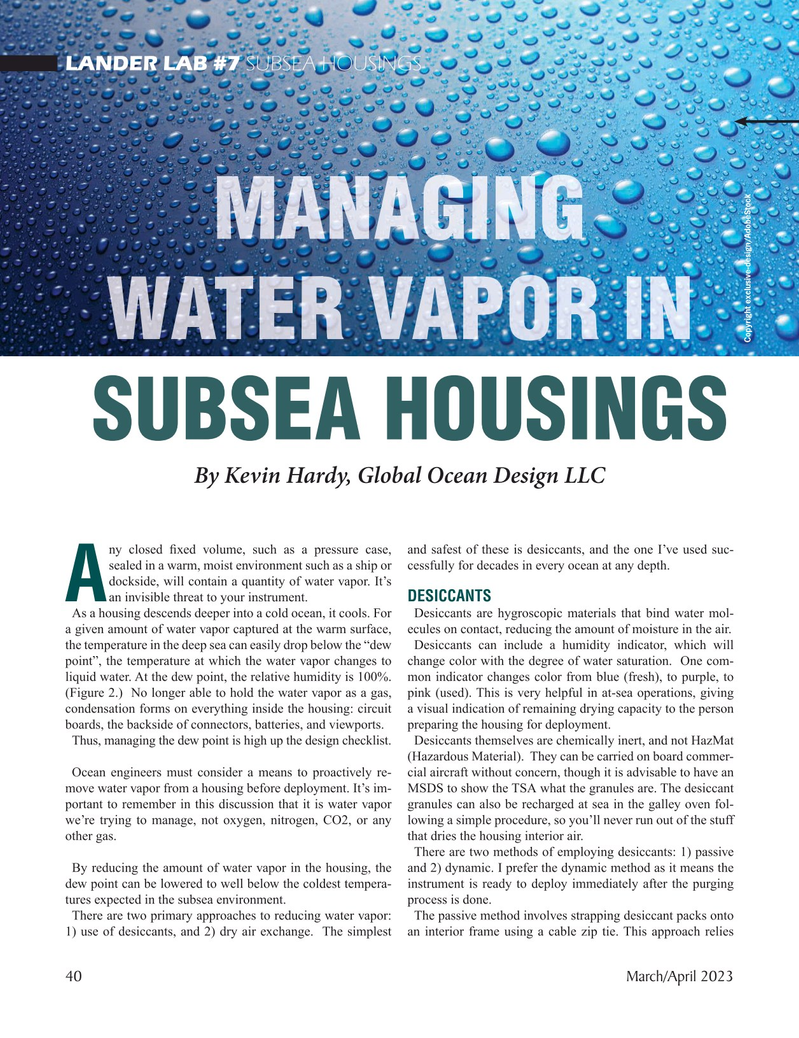
Page 40: of Marine Technology Magazine (March 2023)
Read this page in Pdf, Flash or Html5 edition of March 2023 Marine Technology Magazine
LANDER LAB #7 SUBSEA HOUSINGS
Copyright exclusive-design/AdobeStock
SUBSEA HOUSINGS
By Kevin Hardy, Global Ocean Design LLC ny closed ? xed volume, such as a pressure case, and safest of these is desiccants, and the one I’ve used suc- sealed in a warm, moist environment such as a ship or cessfully for decades in every ocean at any depth.
dockside, will contain a quantity of water vapor. It’s
A an invisible threat to your instrument. DESICCANTS
As a housing descends deeper into a cold ocean, it cools. For Desiccants are hygroscopic materials that bind water mol- a given amount of water vapor captured at the warm surface, ecules on contact, reducing the amount of moisture in the air. the temperature in the deep sea can easily drop below the “dew Desiccants can include a humidity indicator, which will point”, the temperature at which the water vapor changes to change color with the degree of water saturation. One com- liquid water. At the dew point, the relative humidity is 100%. mon indicator changes color from blue (fresh), to purple, to (Figure 2.) No longer able to hold the water vapor as a gas, pink (used). This is very helpful in at-sea operations, giving condensation forms on everything inside the housing: circuit a visual indication of remaining drying capacity to the person boards, the backside of connectors, batteries, and viewports. preparing the housing for deployment.
Thus, managing the dew point is high up the design checklist. Desiccants themselves are chemically inert, and not HazMat (Hazardous Material). They can be carried on board commer-
Ocean engineers must consider a means to proactively re- cial aircraft without concern, though it is advisable to have an move water vapor from a housing before deployment. It’s im- MSDS to show the TSA what the granules are. The desiccant portant to remember in this discussion that it is water vapor granules can also be recharged at sea in the galley oven fol- we’re trying to manage, not oxygen, nitrogen, CO2, or any lowing a simple procedure, so you’ll never run out of the stuff other gas. that dries the housing interior air.
There are two methods of employing desiccants: 1) passive
By reducing the amount of water vapor in the housing, the and 2) dynamic. I prefer the dynamic method as it means the dew point can be lowered to well below the coldest tempera- instrument is ready to deploy immediately after the purging tures expected in the subsea environment. process is done.
There are two primary approaches to reducing water vapor: The passive method involves strapping desiccant packs onto 1) use of desiccants, and 2) dry air exchange. The simplest an interior frame using a cable zip tie. This approach relies 40 March/April 2023
MTR #3 (34-49).indd 40 3/19/2023 7:49:12 PM

 39
39

 41
41
